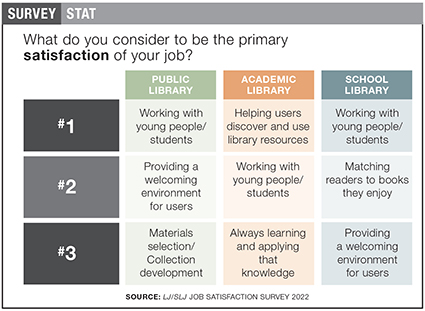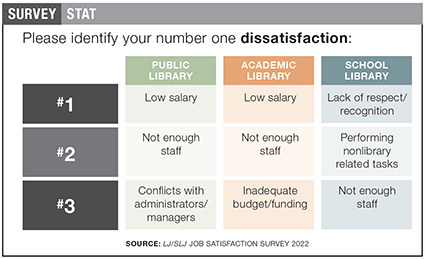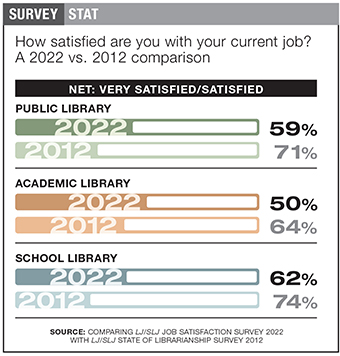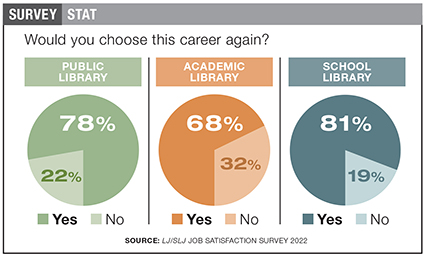Satisfaction (Not Always) Guaranteed | Job Satisfaction Survey 2022
LJ and SLJ’s 2022 Job Satisfaction Survey shows that most librarians are glad they chose their career, but significantly fewer than in 2012.
 LJ and SLJ’s 2022 Job Satisfaction Survey shows that most librarians are glad they chose their career, but significantly fewer than in 2012
LJ and SLJ’s 2022 Job Satisfaction Survey shows that most librarians are glad they chose their career, but significantly fewer than in 2012
Librarians maymake recommendations at the reference desk, but would they recommend their own career choices? Library Journal and School Library Journal’s 2022 Job Satisfaction Survey asked library workers to consider what they liked and disliked about their jobs specifically, and librarianship in general.
This was the first survey looking at job satisfaction since LJ’s overarching “State of Librarianship” survey in 2012. In the intervening years, job satisfaction has dropped notably—from 70 percent of library employees who stated that they were either “very satisfied” (32 percent) or “satisfied” (38 percent) with their positions in 2012 to 56 percent who say the same in 2022.
The survey, conducted in October 2022, received 2,034 responses from employees at 1,133 public, 511 school, 353 academic, and 37 other types of libraries. Respondents have worked an average of 8.2 years in their current positions and 14.4 years in the library field. Their average age is 46.

White women maintain their overwhelming majority in the field: 85.7 percent of survey participants were white, while 5.8 percent were Hispanic or Latine, 3.2 percent Black or African American, 2.5 percent of mixed race, 2.3 percent Asian, 1.5 percent Native American or Indigenous, 0.5 percent Middle Eastern or North African, 0.2 percent Hawaiian or Pacific Islander, and 1.2 percent a race not listed. Respondents were mostly (85.2 percent) women, with 9.5 percent men, 2.5 percent nonbinary, and 0.2 percent write-in (including genderfluid, agender, and dual gender). There were more men, proportionally, among academic library employees (21.9 percent) than in public libraries (7.1 percent) or school libraries (3.4 percent).
Respondents to the new survey listed challenges that include low salaries, understaffing, and a general lack of respect—but the majority of library staff said that they still enjoy working with their patrons. More than three-quarters (77 percent) of respondents answered that they would choose their career again, and 78 percent would recommend librarianship to a young person just entering college—although most with some reservations.

Despite these largely—if not overwhelmingly—positive statistics, the poll’s results show dissatisfaction about aspects of the field relating to salary (the most common area of complaint), lack of adequate staffing, inequity, changes in the field, stress, personal conflicts, and—related to most of these other areas—a lack of respect. The results suggest that job satisfaction has a stronger correlation to feeling respected than to a higher salary.
WHAT’S GOOD
When asked, “What do you consider to be the primary satisfaction of your job?” the most frequent answer among both public and school libraries was “Working with young people/students.” “Helping users discover and use library resources” was the answer most often selected among academic librarians.

Open-ended responses showed genuine enthusiasm for the field. “I’m very much a people person so I enjoy working with the public,” wrote Deon Kramer, adult/public services librarian from Deerfield Beach Library, FL. “I find my job to be very rewarding because I get to help people from all walks of life discover new things and learn new skills.” Others expressed enjoyment at the opportunity to develop new skills and use their creativity, work with their colleagues and patrons, and promote academic freedom.
UNDERPAID AND OVEREXTENDED
Despite these pleasures, library workers also expressed a wide range of dissatisfactions with their work. When asked to identify the top grievance, the most common answer among public and academic libraries was low salary. One academic librarian from Pennsylvania noted that she didn’t earn enough to support herself, adding, “It is no exaggeration to say I could not live independent of my parents on my current salary.”
Despite low salaries, employees are still expected to take on many duties. Among public and academic librarians, not having enough staff was the second most common reason for dissatisfaction. According to an academic librarian in Colorado, “COVID and the Great Resignation have created a huge [number] of job vacancies in our library, and we are having to help cover service points. Hard to hire new [colleagues] when the starting salaries are well below what you can live on here.”
Other respondents shared similar accounts of needing to cover more duties as their colleagues have departed without being replaced by similarly skilled employees. “Between poor leadership and the pandemic, we lost a lot of experienced people,” wrote a public librarian in California. “Staffing was inadequate before the pandemic and everyone has tried to be at least three people ever since. When you are struggling to meet even the basic needs of your patrons and coworkers (and yourself), it’s hard to be innovative and forward-thinking.”
LACK OF RESPECT
A lack of respect or recognition was the third most common source of dissatisfaction among all respondents, and the primary dissatisfaction for school librarians. An academic librarian in Oregon expressed a general frustration with how librarians are regarded and treated: “The lack of respect for a professional position (not to mention our training and experience) is a constant, and although it’s one of those things that I think [we] learn to let roll off our backs, it can be demoralizing.”
Respondents offered accounts of racism, sexism, homophobia, and transphobia directed at them and their coworkers. Having to deal with toxic work cultures, negative atmospheres, political legislation constraining libraries’ academic and intellectual freedom, a lack of IT support, and safety issues—from COVID and from potential violence—also reflect a lack of respect. Several mentioned feeling a lack of safety when dealing with the public.
Discrimination does not necessarily need to be aimed directly at employees to negatively affect their work. An account by a respondent at a South Dakota academic library illustrates this: “We are constantly under attack for attempting to provide a safe space for nonwhite students. We had to rewrite [a] faculty-expectations document to remove the word ‘diversity.’ The most frustrating part is that the problem is not university administration; it is the legislature passing bills that interfere with our ability to provide an accurate view of the world.”
LACK OF TIME, LOW MORALE
When asked, “What is your greatest on-the-job challenge?” the most common response among all types of libraries and library workers was “lack of time to do everything.” The second most common overall, particularly among public library workers, was “staff morale.” “Budgetary constraints” was the second most common answer among academic and school librarians.
Replies were divided among employees citing experiences with their bosses as problems and administrators who expressed their challenges with staff. Daniel Neeves, senior librarian at Siouxland Libraries, SD, wrote, “Mostly because of staffing shortage, morale has been low. It can be a challenge to help [employees] see that we’re on a good track and there is light at the end of the tunnel.”
OVERALL SATISFACTION
Even with a range of challenges, a modest majority of respondents (56 percent) stated that they were either “very satisfied” (22 percent) or “satisfied” (34 percent) with their current job. School librarians represented 62 percent of the total “very satisfied”/“satisfied” answers; public library employees made up 59 percent of that number. Among academic librarians, only half expressed satisfaction with their jobs—a noticeably lower proportion than other groups.

Levels of satisfaction varied among people of different races and genders. Fifty-eight percent of white respondents were satisfied with their jobs. Fifty-two percent of library staff who are Latine, 48.8 percent who are mixed race, 47.5 percent who are Asian, and 43.6 percent who are Black or African American report this same level of satisfaction.
While women expressed being slightly more satisfied with their jobs than men—57 percent for women and 53.9 percent for men—only 43.8 percent of respondents who are nonbinary or genderfluid were similarly positive about their work.
Satisfaction also varied according to levels of education. Those without postgraduate degrees were the most content, with 62 percent expressing “very satisfied” or “satisfied.” This dipped slightly among those with postgraduate degrees other than the MLS (61 percent), and dropped considerably for those with MLS degrees (53 percent).
Satisfaction did not vary significantly based on the number of years in librarianship. However, it was more common among people age 45 or older (59 percent) than among those under 45 (53 percent).
Most participants (77 percent) reported feeling “very secure” (36 percent) or “secure” (41 percent) about their jobs. The most insecurity was among academic librarians, with only 32 percent “very secure” and 40 percent “secure.”
THE MATTER OF SALARY
The number-one area of dissatisfaction: salary. Mean full-time annual salaries were $65,200 and the median $61,700, with academic and K–12 librarians averaging over $68,000 and public librarians averaging $60,200. People without graduate degrees earn the least, averaging $46,100, versus the $67,700 average paid to those with MLS degrees or the $72,400 that people with other postgrad degrees earned.
Respondents who identified as Asian earned an average of $74,500, the highest among the racial and ethnic groups surveyed. BIPOC (Black, Indigenous, and people of color) library staff overall earned an average of $66,000, followed by white library workers at $64,900. Black and African American respondents averaged $68,700, while Hispanic or Latine library workers earned an average of $63,000, and people of mixed race $62,200.
The average male respondent’s full-time salary was $69,000, more than the average women’s $65,100 and considerably more than $53,000, the average salary among people who are nonbinary or genderfluid. Thirteen percent of women and 15 percent of men identified their positions as senior administration.
Salary does not necessarily correlate with job satisfaction. People who were not very or not at all satisfied with their jobs earned an average of $65,900, $800 less than the $66,700 made by the average “satisfied” and “very satisfied” person.
Some dissatisfaction appears to come from the sense of being underpaid in comparison with peers. When asked to compare their salaries with others, the majority (63 percent) felt they were paid comparatively with others in similar library positions. Academic librarians were the most likely to consider themselves underpaid in this regard—44 percent thought so. However, nearly three-fourths (73 percent) of all participants considered themselves underpaid compared with people in other fields with similar education and experience.
EDUCATION AND ADVANCEMENT
Two-thirds (68 percent) of survey participants have an MLS or MLIS degree, and 15 percent possess another advanced degree. Most (86 percent) of those with library degrees are in positions requiring such credentials; this jumps to 94 percent among youth services librarians in public libraries.
Of those with an MLS or MLIS, only 58 percent said that their library school prepared them for their career. What should library schools have taught these future librarians? In an open-ended question, many suggested less theory and more practical information, and expressed the wish to have had instruction on strategies such as dealing with difficult patrons, offering social services, managing employees and facilities, programming, and using technology. A reference/information services librarian at a public library in Indiana had a suggested lesson: “Always expect the unexpected. No one told me I would have to unstop a toilet, call the police, call the fire department, etc.”
In the last year, 62 percent of respondents have received a raise averaging 4.3 percent. Ten percent of respondents received a promotion. Eight percent started a new job. Responsibilities changed as well; 38 percent voluntarily took on more responsibilities, and 31 percent were assigned more because of staff cuts. More than a quarter (28 percent) were assigned a project that stretched and added to their knowledge. In contrast, 24 percent felt that they were assigned mundane tasks that wasted their expertise. Nineteen percent stated, “I am expected to be more fluent in technology and social media,” and 16 percent said, “I was assigned functions for which I am not trained/suited.”
Most respondents did not feel positive about their opportunities for advancement. A quarter (25 percent) rated their odds of advancement as “fair,” and 44 percent considered them “poor.” Half (52 percent) of school and academic librarians felt that their advancement opportunities were poor; perhaps unsurprisingly, 71 percent of respondents who rated this category poor also felt “not too satisfied” or “not at all satisfied” with their jobs.
 THE BIG QUESTIONS
THE BIG QUESTIONS
With all of these considerations—the good, the bad, and the ambiguous—how do library workers feel about their careers? Perhaps the most telling question is whether or not they would choose to pursue librarianship again. Three-fourths (77 percent) said they would, although this ranges from 68 percent in academic libraries to 81 percent in school libraries. Only 36 percent of those who answered that they were unsatisfied with their current jobs would choose their careers again.
About half the participants (52 percent) made the decision to become librarians after working in another field, although that number drops to 41 percent among academic librarians. Fifty-eight percent of these career changers are satisfied with their current jobs.
Two-thirds (65 percent) intend to stay in librarianship until they retire, with 30 percent unsure. Eighty-one percent of those who are satisfied with their jobs intend to stay in the profession until retirement, compared with only 34 percent of those who are dissatisfied.
Another test of the overall satisfaction with librarianship is whether or not respondents would recommend this career path to a young person entering college. Twenty-two percent would do so enthusiastically, 56 percent would do so with reservations, 17 percent probably would not, and 5 percent definitely would not. Jacquie Owens, adult/public services librarian at Baldwinsville Public Library, NY, offered, “It is important for a young person to understand that they won’t be millionaires but will have a satisfying career helping people.”
Nevertheless, 40 percent of the participants have actively searched for a new job in the past year—26 percent in another library and 14 percent outside of librarianship. About half (51 percent) have not looked for another job in the past 12 months.
Library workers acknowledge the conflicts, obstacles, and frustrations they face, yet the majority still find pleasure in their work—with caveats.
“I think the variety is tops, because it also encompasses autonomy and the ability to learn new things all the time. Never boring!” said one academic librarian. “Though that’s also due to having too much to do.”
Andrew Gerber, Young Adult and Media Librarian for North Brunswick Public Library, NJ, has previously written articles for LJ and Medical References Services Quarterly.
RELATED
ALREADY A SUBSCRIBER? LOG IN
We are currently offering this content for free. Sign up now to activate your personal profile, where you can save articles for future viewing









Add Comment :-
Comment Policy:
Comment should not be empty !!!